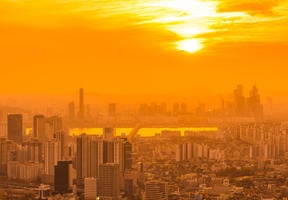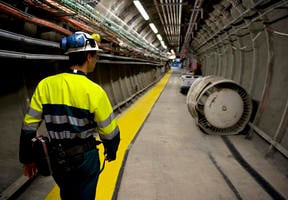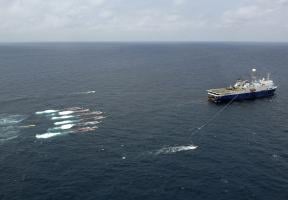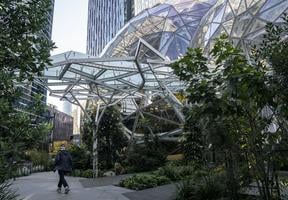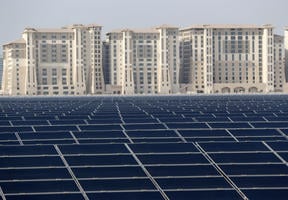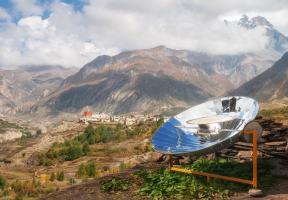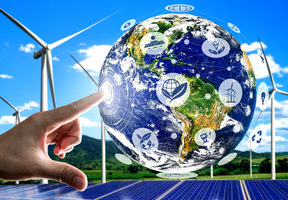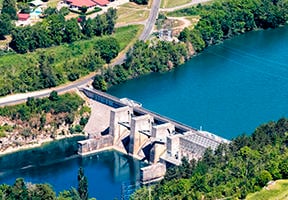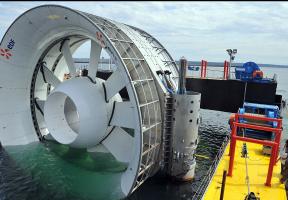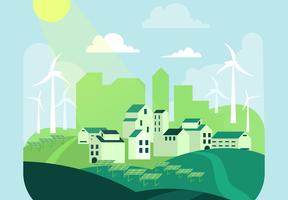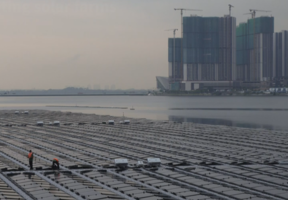Réunion Island: The Challenging Path to Energy Independence
Published on 03.02.201810 min read
One of the five French overseas regions1, Réunion Island is located on the Indian Ocean cyclone path and has a tropical climate. The volcanic island, which is three times smaller than Corsica, is home to one of the world’s most active volcanoes: the Piton de la Fournaise (Peak of the Furnace). Economic activity is concentrated along the coasts, where the cities of Saint-Denis, the capital, and Saint-Pierre are located. Due to the high birth rate, the island’s population rose from 600,000 in 1990 to 850,000 in 2015. This growth, along with significant tourism development, has caused energy consumption to increase by 40% since 2000.

© GERARD CERLES / AFP - Réunion Island is leveraging its wealth of sunlight to develop photovoltaic solar power, even though its geography does not lend itself to large-scale parks.
Heavy Reliance on Fossil Fuels
Like most overseas territories, Réunion Island is heavily dependent on imported fossil fuels2. Of the 1,427 thousand metric tons of oil equivalent of consumption in 2016, 1,236 ktoe were imported, 70% of which were oil and gas and 30% . Originating from South Africa, this coal is used to generate .
Apart from the used by power plants, most of the fuels go toward transportation: 71% for road and 28% for air. Given the island’s extremely mountainous center, transportation routes generally run along the coast. Roads are often congested and the public transportation system is underdeveloped. Energy use in the road transportation sector has been constantly increasing since 2000, rising from 322 ktoe to 442 ktoe in 2016. Within this consumption, the share of increased from 56% to 78%.
(253 ktoe generated in 2016) is produced by coal for 39% and heavy fuel oil and diesel for 27%.
Local Resources
, water and the sun are Réunion’s only meager local energy resources, providing the tropical island with just 191 ktoe, or 13%, of its needs.
In terms of primary energy, more than half of these local resources are made up of bagasse, the fibrous residue left over from crushing sugarcane. Like in Brazil, it is used to generate for the residential, tertiary and sugar sectors, as well as electricity.
Solar energy – half photovoltaic, half thermal – has now overtaken hydropower (43 ktoe compared with 40 ktoe). Thanks to the large Takamaka and Rivière de l’Est plants, hydropower has been used on the island for decades, but its output has varied considerably each year due to irregular rainfall.
Hydropower represents 16% of power generation, bagasse 8%, photovoltaic solar power 8% and other sources (wind, , etc.) 2%. Since 2005, the 34% penetration rate of renewable energies in total power generation has been stable and growth in these energies has been absorbed by increasing needs.
Objectives
Against this backdrop, the main objective is to reduce the island's energy dependency ratio, that is, the relationship between local resources and total consumption of primary energies (including imports). Since 2015, the dependency ratio has been around 87%3.
Driven by the State and local bodies, an “Energy and Climate Plan” was adopted in December 2014 and confirmed as part of the multi-year energy plan in December 20164. The plan aims to:
- Make renewable energies account for 50% of the by 2020 and work toward for electricity by 2030.
- Reduce by 10% the volume of fossil fuel imports by 2020.
- Improve by 10% by 2020 and 20% by 2030, with a focus on consumption by households and public institutions.
Means of Action
Transportation – The multi-year plan for Réunion Island recommends developing public transportation, installing cable cars, increasing electric mobility in terms of corporate fleets and last-mile logistics, and stepping up communication to raise awareness among users. It should be noted that the reliance on imports raises the actual cost of fuel. However, the rules of national solidarity mean that maximum sale prices are set for the various fuels in line with the prices in mainland France.5
Renewable energies – There are few natural sites that can still be used for hydropower and only some extensions to existing facilities and very small plants are foreseen. Use of wind power is very limited due to highly unpredictable wind conditions and Réunion’s protected environment (the island is a UNESCO world heritage site). Solar power is therefore a priority, particularly for local use. With of 165 megawatts, solar power rose by 44% between 2011 and 2015, and is expected to increase by a further 20 megawatts by 2018 and 30 megawatts by 2023. Yet even here, the lack of space prevents large solar parks from being built. The 9-megawatt Bardzour plant, for example, is combined with greenhouses. Micro-grid systems have been installed in the most remote areas, such as Cirque de Mafate, which is home to 300 families and can only be reached on foot or by helicopter. Solar thermal power is being developed for domestic use, with 135,000 solar water heaters already installed on the island, or one in almost every second home.
Despite being a volcanic island, there are no facilities. Studies are underway to locate resources outside the scope of the UNESCO world heritage status.
Advanced Research
In terms of marine energy, an prototype for capturing the sea’s thermal energy has been installed in Saint-Pierre. It is one of three testing grounds for this technology worldwide.
A sodium-sulfur battery with a 1-megawatt storage capacity was installed in the town of Saint-André in 2010. A battery installation of a total of 5 megawatts is also planned. Like Germany and the United Kingdom, France wishes to develop its storage capacities (excluding hydraulic pumps) in order to more effectively manage the intermittent nature of solar and wind power, and aims to achieve 100 megawatts by 2020. The French islands alone could provide for half of that goal.
Sources:
- France has five overseas departments that also double as regions: Guadeloupe, Martinique, French Guiana, Réunion Island and Mayotte. It also has five overseas collectivities: Saint Pierre and Miquelon, Saint Barthélemy, Saint Martin, Wallis and Futuna, and French Polynesia. New Caledonia is a collectivity with its own special status. The French Southern and Antarctic Lands are administered from Réunion Island. Clipperton Island is under the direct authority of the French government.
- See the energy report (in French only)
- By comparison, this ratio is 82% in French Guiana, 87.5% in Corsica, 88% in Guadeloupe and 94% in Martinique.
- See the Energy and Climate Plan (in French only) and the multi-year plan (in French only).
- At January 1, 2018, the maximum prices were €1.12 per liter for diesel and €1.43 for unleaded gasoline. See the official website (in French only).

